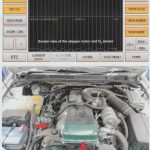There are three ways to diagnose an engine problem using OBD2 codes in your Ford. The first method involves identifying the error code with the help of the manual. This will let you know if your car is experiencing a variety of problems. The second method requires using an OBD2 scanner, which you can purchase online. Once you’ve installed the scanner, you can follow the simple instructions to read the code.
P0305 code means that cylinder 5 is randomly misfiring
If your car has received the P0305 error code, you’re probably wondering what it means. The code means that cylinder number 5 is misfiring. The reason it is happening is because the timing of the ignition is not right. When a cylinder fires at a different time from the others, the engine doesn’t produce as much power as it should. It’s important to note that ignoring the misfire may result in further engine damage. Using the car despite this error can decrease your fuel economy and increase repair costs. You can even damage the ignition system and have it fail entirely. Ultimately, the P0305 error code is a warning that your engine needs repair.
There are two main types of misfires: small and large. Obviously, the latter is more serious. The key is to determine which one is causing the problem and how serious it is. Typically, misfires are only noticeable when there is a significant amount of them. But even a small misfire can quickly escalate into a major problem if you ignore it. You’ll want to check your spark plugs to make sure they’re not the issue. The spark plugs are a cheap and easy way to fix the P0305 problem.
Another possible cause of the P0305 trouble code is low compression. The engine may be undergoing a misfire, and low compression will result in decreased power. To find out what’s causing the misfire, you’ll need to test the parts of the ignition system. The most likely culprits are the plugs, wires, and coil packs. It’s important to have your car checked as soon as possible to prevent further damage.
The P0305 code will also mean that cylinder number five is misfiring. A misfire in cylinder number five can cause the engine to fail and will lead to a Check Engine light. This code will not tell you what is causing the misfire, but it will help you identify the problem and repair it. The misfire may be caused by a worn out spark plug or a malfunction in the ignition.
P0605 code means that there’s a problem with your ECM’s ROM
The P0605 OBD2 code is an indicator that the powertrain control module (PCM) has a problem reading its ROM. It could be a problem with the PCM itself or with one of the supporting control modules. The PCM is responsible for monitoring and adjusting the different functions of your vehicle. However, when the PCM becomes faulty, it can cause your car to malfunction or have a P0605 OBD2 code. Cables may be worn or damaged, or an internal problem with the PCM/ECM.
This error will cause your vehicle to experience decreased fuel economy. All performance problems have a common cause. Fuel pressure can cause a decrease in fuel economy, or it could also affect the throttle body. Moreover, a car may hesitate to shift gears, which can cause extensive transmission damage. However, the P0605 error means that there’s a problem with the fuel control module, so it’s important to get it fixed as soon as possible.
When you encounter a P0605 OBD2 code, you’ll want to take your car to the shop for a proper diagnosis. It’s essential that you have the correct ECM diagnostic test done as this code can lead to more serious issues. A qualified technician will be able to diagnose the problem, as well as check for any necessary updates and recalls.
If you’ve tried repairing a P0605 code on your own, you’ll probably discover that the issue is with the ROM of your ECM. You’ll need to buy a new ECM if the problem persists, but you’ll also need to purchase a new one. This is the easiest way to fix your car’s P0605 error code.
The ECM controls many of your car’s major functions. They include ignition timing, anti-lock-braking, fuel injection, traction control, electronic power steering, and other important functions. But if the ECM’s ROM becomes corrupted, your car’s engine performance will be compromised. You may even lose the ability to start your vehicle at all.
P0223 Throttle Position Sensor B circuit Input Low
If you have a malfunctioning throttle body, you can suspect the cause of the code P0223. The throttle body receives signals from the Powertrain Control Module (PCM) and changes resistance based on the movements of the accelerator pedal. It relies on these signals to operate the throttle valve and provides detailed information about the width of the valve opening. If you have this code, the next step is to find the source of the problem.
The problem could be related to the Throttle Position Sensor. This sensor may be faulty, or it may have an open circuit or low voltage. If you’ve recently replaced the TPS, you may need to adjust the voltage. Sometimes, clearing the code will help, but intermittent problems will require you to repair the issue first. It’s important to find the source of this problem, as some vehicles have different TPS adjustments.
The first step is to locate the cause of the P0223 Throttle Position Sensor B Circuit Input Low error code on your car. The problem is typically caused by a malfunctioning throttle position sensor. The throttle position sensor sends a descending voltage signal to the powertrain control module. The ECM uses this signal to manage the engine components.
Another way to check if the TPS is malfunctioning is to use a scan tool. This allows you to diagnose the fault in the vehicle. The scanner’s output signal is not visible, but it should be at least 5 volts. You can also trace the voltage by using an oscilloscope. If you’re unsure of the voltage, use a professional code reader that can display this signal.
When a TPS is malfunctioning, it can cause the engine to lean out or hesitate when acceleration begins. The reason for this lean-out problem is due to a low signal from the TPS. However, the oxygen sensor feedback circuit will eventually provide the necessary information. If the TPS is not functioning properly, the problem could be as simple as the throttle position sensor or a different part of the car.
P0231 Fuel Pump Primary circuit Fault
If you’re having trouble with the fuel pump in your Ford, the P0231 code may mean that the pump’s relay has blown. This can happen to any Ford with OBD-II systems. If this happens to your car, you can fix it yourself with some simple electrical tape and a basic wire splicing tool. If you can’t fix the issue yourself, you can always purchase a replacement fuel pump.
The primary cause of this error code is a low voltage in the primary power circuit of the fuel pump relay. The PCM monitors this voltage to determine if it is below manufacturer specifications. In some cases, the voltage may be too low and the fuel pump is getting too much power. To fix the fuel pump primary circuit fault, you can perform a pinpoint trouble code test. This will identify the primary side of the fuel pump circuit.
If the voltage is low, the problem is likely in the circuit itself. To fix the problem, you need to check the fuel pump relay’s resistance by bench-testing the circuit and the relay. You can test the relay by powering the primary circuit and measuring the resistance across the secondary circuit. To swap relays, make sure to mark the original locations. It’s easier to fix the problem if you have a known good relay.
If your fuel pump relay has stopped working, you should visit your mechanic immediately. The P0231 code is caused by a malfunction in the fuel pump relay. Fuel pump relays are controlled by the engine computer and the Fuel Pump Control Module. The fuel pump controller module controls the fuel pump and sets the P0230 code. Depending on your vehicle, you may need to take the car to a repair shop to have it fixed.






